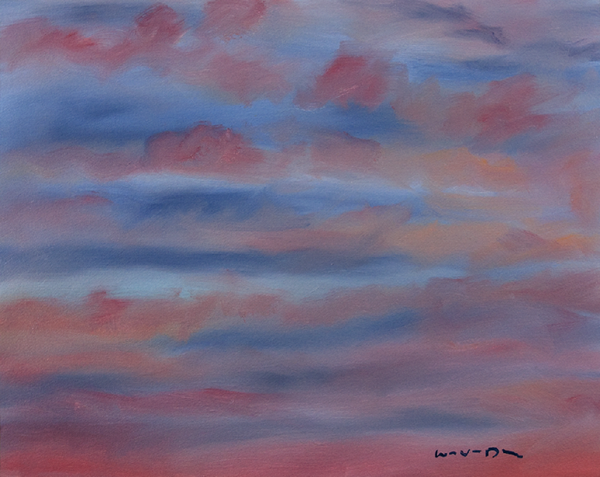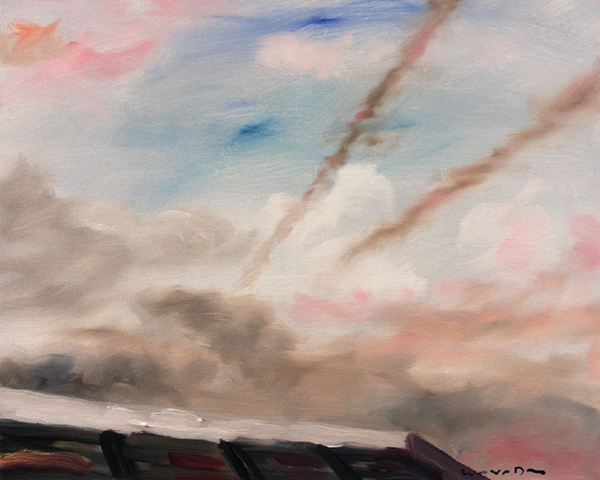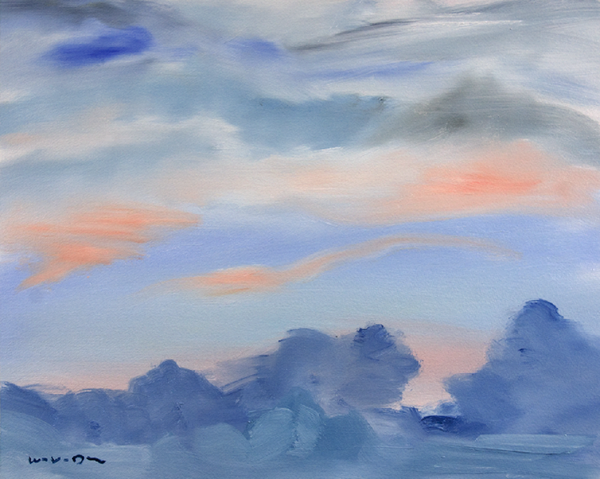 Sunday, November 6, 2011 at 06:41PM | by
Sunday, November 6, 2011 at 06:41PM | by  BVD | in
BVD | in  A Painting A Day,
A Painting A Day,  Sunset Paintings | tagged
Sunset Paintings | tagged  Charlottesville Virginia,
Charlottesville Virginia,  University of Virginia,
University of Virginia,  William Theodore Van Doren,
William Theodore Van Doren,  skyscape | |
skyscape | |  Post a Comment
Post a Comment  Sunday, November 6, 2011 at 06:41PM | by
Sunday, November 6, 2011 at 06:41PM | by  BVD | in
BVD | in  A Painting A Day,
A Painting A Day,  Sunset Paintings | tagged
Sunset Paintings | tagged  Charlottesville Virginia,
Charlottesville Virginia,  University of Virginia,
University of Virginia,  William Theodore Van Doren,
William Theodore Van Doren,  skyscape |
skyscape |  Share Article |
Share Article |  Post a Comment
Post a Comment While reading about Edgar Allan Poe’s “The Island of the Fay” (for yesterday’s post), I wondered about the source for the story’s setting. According to a Wikipedia article, another Poe story (“A Tale of the Ragged Mountains”) is “the only one of Poe’s stories to take place in Virginia.” I doubt very much that this is true.
“A Tale of the Ragged Mountains” might be the only Poe story set explicitly in Virginia, but considering Poe’s biography and where he lived at different times in his rather brief life (only 40 years), these low but rugged mountains emerge as a compelling candidate for the wild landscape that may have influenced several of his writings.
A well-researched article on Poe’s one year at the University of Virginia in Charlottesville reports that “in the afternoons, Poe was reputed to take long solitary walks through the nearby hills ...” In “A Tale of the Ragged Mountains”, Poe gives this habit to his main character. He would
set forth alone, or attended only by a dog, upon a long ramble among the chain of wild and dreary hills that lie westward and southward of Charlottesville, and are there dignified by the title of the Ragged Mountains.
Poe later has his character say that “when I left Charlottesville ... I bent my steps immediately to the mountains” – this is probably what Poe himself was once in the habit of doing.
In “The Island of the Fay,” the place where the narrator walks is described in a manner very reminiscent of his account of the Ragged Mountains.
It was during one of my lonely journeyings, amid a far distant region of mountain locked within mountain, and sad rivers and melancholy tarn writhing or sleeping within all – that I chanced upon a certain rivulet and island.
Poe’s ‘fancy’ could take something very small and seemingly insignificant – like a piece of sycamore bark floating by – and blow it up into something central to a story. There is every possibility that the ‘river’ where “Fay” is based indeed was nothing more than a ‘rivulet’, and the island perhaps not much more than a typical small feature of a Virginia creek, no more than a few meters from end to end. Setting off from the university “southward and westward” as he says, and following the Ragged Mountains, Poe would encounter the main branch of Moore’s Creek, which today feeds a reservoir near the university. Traveling further south, he’d reach the Hardware River; either stream would have been quite suitable as the basis for “The Island of the Fay.”
Based on the other places where Poe spent his adult life – Philadelphia, New York and Baltimore, with a military assignment to Charleston, South Carolina – it seems likely he would have become familiar with territory like that in “The Island of the Fay” (and perhaps even the setting of “The Fall of the House of Usher”) in the Ragged Mountains. Another possibility might be the area near West Point, where he spent about eight months trying mightily, and finally succeeding, to get himself kicked out of the U.S. Military Academy. And of course there’s the fact that he was brought up during part of his childhood in Scotland and England, and was always perfectly capable of simply making up his own worlds. But I suspect the Ragged Mountains provided a reserve of impressions that he drew upon for ‘wild’ scenery.
An aside: Having just recently written about the possible meaning of ‘Indian Summer’ and also the prevalence during that time of a combination of “sun, dust, smoke and shadow – a medium that contains and conducts autumn” – I enjoyed encountering Poe’s reference, in “A Tale of the Ragged Mountains,” to
a dim, warm, misty day, toward the close of November ... during the strange interregnum of the seasons which in America is termed the Indian Summer
and his description of
the thick and peculiar mist, or smoke, which distinguishes the Indian Summer ... this pleasant fog
Of course, some people, influenced by malicious, largely untrue tales disseminated about Poe during his lifetime, may think I’m seeking corroboration from an addicted madman. Well, Happy Halloween to them.
Finally, even further aside. I’ve written quite a bit (here, here, here and here) about my uncle, the late photographer and commercial filmmaker Del Ankers. Getting a gift for my uncle Del was the closest thing we knew to trying to find something for the fabled ‘man who has everything’. The D.C. studio/home of Del and my aunt Elizabeth was a marvel to my siblings and me, filled with exotic things like glass-topped tables, curved, leather-covered sofas, fresh fruit set out in bowls (and you were actually encouraged to eat it), sumptuous atlases and coffee table books on the aforementioned tables, not to mention all the photo stuff in the studios. The best things were the crazy toys on Del’s desk – not toys for us, souvenirs and amusements for him.
I only ever managed to find two or three things worth giving Del for his collection. One of them dates from just a few years ago, a toothpick dispenser I also just had to get for myself. Works great. And it can close our chapter on Edgar Allan Poe.
 Saturday, October 31, 2009 at 07:07PM | by
Saturday, October 31, 2009 at 07:07PM | by  BVD | tagged
BVD | tagged  Charlottesville Virginia,
Charlottesville Virginia,  Del Ankers,
Del Ankers,  Edgar Allan Poe,
Edgar Allan Poe,  Hardware River,
Hardware River,  Moore’s Creek,
Moore’s Creek,  Ragged Mountains,
Ragged Mountains,  University of Virginia,
University of Virginia,  indian summer,
indian summer,  “A Tale of the Ragged Mountains”,
“A Tale of the Ragged Mountains”,  “The Island of the Fay”,
“The Island of the Fay”,  “The Raven” |
“The Raven” |  Share Article | Comments Off
Share Article | Comments Off  William Theodore Van Doren. Stony Point, Albemarle County, Va. Oil on paper, 16 x 20.
William Theodore Van Doren. Stony Point, Albemarle County, Va. Oil on paper, 16 x 20.
I’m happy to report that the October 1st sunset, as seen from the field at Scott Stadium at the University of Virginia shortly before MUSE took the stage to open for U2, has finally been posted.
Complex man-made structures, if I don’t have an opportunity to paint them live on the spot, can be tricky for me to deal with. When I’m painting directly from the scene, there’s little danger that I will plan or overthink – everything just happens. But if I carry away a detailed sketch and then try to reconstruct that scene, art can lose itself in an earnest attempt to RECONSTRUCT THAT SCENE. I painted that (October 1st) sky only when I was ready to treat the stadium the way I would anything else, leave out anything I cared to leave out, make it personal, simply deal with it naturally. Had I painted on the spot, I know I would have put in something for the tall narrow light standards, but working from a sketch this would have been architectural and deadly.
I did the sketch on the back of the top of a mini pizza box I ‘borrowed’ from a neighbor down in the General Admission standing area. (She’d finished her dinner.) Those little box lids make nice sketch surfaces – the flared sides create almost a shadowbox effect – mini pizza cartons, suitable for hanging.
 BVD
BVD
 Saturday, October 10, 2009 at 07:55PM | by
Saturday, October 10, 2009 at 07:55PM | by  BVD | in
BVD | in  Sunset Paintings | tagged
Sunset Paintings | tagged  MUSE,
MUSE,  Scott Stadium,
Scott Stadium,  U2,
U2,  University of Virginia,
University of Virginia,  painting process |
painting process |  Share Article | Comments Off
Share Article | Comments Off  William Theodore Van Doren. Scott Stadium, University of Virginia, Charlottesville. Oil on paper, 16 x 20.
William Theodore Van Doren. Scott Stadium, University of Virginia, Charlottesville. Oil on paper, 16 x 20.
From the U2 360° Tour, presented by BlackBerry [“BlackBerry Loves U2”], at the [naming rights] Carl Smith Center and the [naming rights] David A. Harrison III Field at [old-fashioned name, may not have involved a monetary transaction] Scott Stadium, here’s the William Theodore Van Doren sunset, brought to you by ... brought to you by ... hey, I got nothin’ ...
 Friday, October 2, 2009 at 07:00PM | by
Friday, October 2, 2009 at 07:00PM | by  BVD | in
BVD | in  Print/Cards Available,
Print/Cards Available,  Sunset Paintings | tagged
Sunset Paintings | tagged  360° Tour,
360° Tour,  BlackBerry,
BlackBerry,  Carl Smith Center,
Carl Smith Center,  Charlottesville Virginia,
Charlottesville Virginia,  David A. Harrison III Field,
David A. Harrison III Field,  Scott Stadium,
Scott Stadium,  U2,
U2,  University of Virginia,
University of Virginia,  commerce |
commerce |  Share Article | Comments Off
Share Article | Comments Off  William Theodore Van Doren. Stony Point, Albemarle County, Va. Oil on paper, 16 x 20.
William Theodore Van Doren. Stony Point, Albemarle County, Va. Oil on paper, 16 x 20.
My brother Michael Addison Van Doren, of Austin, Texas, the most astronomically inclined of all our fanatically meteorologically inclined clan, advises us to check out the Perseids in that “universal palette,” the sky, and make our own “attestation to the heavens.” (Yes, he’s even worse than I am, I believe.) He quotes his fellow University of Virginia–based dreamer and wanderer, Poe, from “Evening Star”:
’Twas noontime of summer,
And mid-time of night ...
My excuse for forgetting the Perseids has been clouds, clouds, clouds. In the woods today with Flint there was full cloud cover and a little rain, so I was surprised for an instant by sunlight over the ground – didn’t make sense. There was the thick brown-gray dead-leaf layer, then green running cedar all over the place. Everywhere in the cedar, little dogwood seedlings had popped up, two or three leaves each, and less than a foot high. Those that probably won’t make it had turned yellow – little groups of dying dogwoods. Pale yellow dogwood sunlight.
 Wednesday, August 12, 2009 at 09:05PM | by
Wednesday, August 12, 2009 at 09:05PM | by  BVD | in
BVD | in  Prose,
Prose,  Sunset Paintings | tagged
Sunset Paintings | tagged  Edgar Allan Poe,
Edgar Allan Poe,  Flint the foxhound,
Flint the foxhound,  Michael Van Doren,
Michael Van Doren,  Perseids,
Perseids,  University of Virginia,
University of Virginia,  “Evening Star” |
“Evening Star” |  Share Article | Comments Off
Share Article | Comments Off
Jefferson’s Country
So, my brother Michael, in Texas, and I had this little e-mail exchange today that gave me a chance to rail curmudgeon-like against two of my favorite bugaboos, Thomas Jefferson, and his town, my town (more or less), Charlottesville, Virginia, and environs.
And there already I’ve overstated or misstated things, since, for example, I also greatly admire Thomas Jefferson, read Dumas Malone’s monumental biography, still for example get a kick out of discovering that Jefferson and I share a habit of washing our feet in cold water, in all weathers – but, in any case, it’s great fun to overstate views that aren’t popular.
Mike sent me, without comment, a link to a Maira Kalman illustrated commentary on Jefferson in The New York Times, titled “And the Pursuit of Happiness: Time Wastes Too Fast,” published on the 25th of June.
So I said to Mike:
And I should say here that I also admire and like Maira Kalman specifically – and the ‘graphic novel’ style of writing in general – people like Kalman, Marjane Satrapi, Art Spiegelman, et al. It’s just that this particular post of Kalman’s, along with another I’d read about Barack Obama’s inauguration day, had struck me as veering at times into some sort of ‘cute’ or even ‘lite’ awestruck worship of her subjects. It can be vaguely cloying, but I’m also probably being too critical.
Here in Charlottesville/Albemarle, ‘Mr. Jefferson’ is everywhere. (He has to be referred to as ‘Mr. Jefferson’ – a practice that bugs me and I believe would have to bug him.) We are reminded daily, most often but not always in various commercial slogans, that we live in ‘Jefferson’s Country.’
Kalman’s homage to TJ gave me the chance to sound off to Michael.
And:
One of Kalman’s key Jefferson quotes:
I think it’s mostly the slave support system that really bothered me about this, but:
I love to try to scandalize my brother. He’s a graduate of Thomas Jefferson’s beloved creation, the University of Virginia. Mike allowed as to how he was fine with my comments but that, “For most UVa grads, brother, you’re talking trash.” Then he said:
Sure enough, Kalman:
Rephrase that as “The monumental man had awful flaws.” Not quite the same, is it?
We love you, TJ. You deserve better from us.